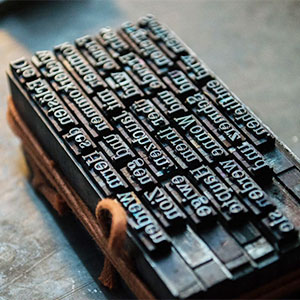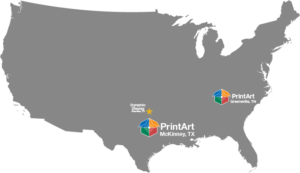The words that we see on paper or, for that matter, on many other media such as plastic, glass, wood, or as embossed on visiting cards, is a technique made possible due to the art of printing. It is a form of technology that is defined as a process that helps reproduce copies of texts and images, mostly using ink on paper with the help of a machine called the printing press. This entire process is then termed publishing and includes newspapers, magazines, publicity leaflets and brochures, newsletters, and many other forms that essentially serve the objective of disseminating information through the written word.
The history of printing is long and interesting. It was first conceived and developed in China and there is evidence to indicate that primitive woodblock printing was in use by the sixth century. The oldest surviving book that was published using the technique of block printing dates back to 868 AD. This is the Diamond Sutra, a Buddhist scripture. The movable type printer was the creation of Pi Sheng in 1040 and the movable type metal printing press was invented in Korea as early as in the year 1234. By the 12th and 13th centuries, many Arabic and Chinese libraries were stocked with tens of thousands of printed books – such was the popularity attained by printing.
Later, the Chinese printing technology found its way into India and Europe because of the trade routes and further development came to the fore when Johann Gutenberg, a German technologist, worked in collaboration with Johann Fust and Peter Schoffer to make a printing press with raised and movable type with oil-based inks. This system led to more experimentation and by 1628 it had helped establish the well known Cambridge Press in North America. Meanwhile, printing also assumed various other forms such as the method of engraving on wood and other materials.
Since those days, printing technology has become a fine art, and books and newspapers are now printed using the technique of offset printing. There are other techniques too such as relief print that is mostly used for catalogs, screen printing, rotogravure, and digital-based inkjet and laser printing, each one of them having its own advantages that can be tapped for the kind of publishing results required. The four types of printing are relief printing, lithography, intaglio, and screen process printing. In intaglio, the image is incised into a surface. Copper or zinc plates are usually used, and the image is etched or engraved on the surface.
Among these, the lithographic process is widely used. It is a manual process based on the repulsion of oil and water. In lithography, flat stones, thin metal, plastic, and paper plates can be used. On the plate, there’s a drawing made with greasy ink or water mixed with crayons. The plate is then inked for printing and the wet parts do not accept the ink while the greasy ones do. For screen process printing, a silkscreen is used which works like a stencil. The ink is applied to the back of the image carrier and pushed through porous areas corresponding to the structure of the design. Digital printing, the most popular in today’s age, uses an electrical charge to transfer toner or liquid ink to the substrate that it is going down on. Its quality has remarkably improved through the years from black and white to color.
When it comes to printing technology, the most revolutionary innovation has been the introduction of photocomposition machines for setting type by photographic means. Now, further advancement has prompted newspapers and magazines to use pagination systems or specially designed page-making software that helps electronic composition, the output of which can be directly transferred to negatives and then on to plates which can be used for the final printing process. Rotogravure is a type of intaglio printing that involves engraving the image onto an image carrier.
To obtain a consistently good quality of reproduction, the method usually employed is offset printing where the inked image is transferred from a plate first to a rubber blanket and then to a printing surface. The other forms of printing include security printing that deals with such items as banknotes, passports, stock certificates, postage stamps, and identity cards. Here, the main objective is to produce items that cannot be forged.
Hopefully, this has shed a little light on the history of printing. It can be a fairly complex process but don’t feel overwhelmed, reach out to PrintArt today, and explain your needs. Their customer service department will put together a cost-effective quote and help your vision come to reality!
PrintArt – Accurate Die Cutting
413 Interchange St.
McKinney, TX 75071
972.562.7921
https://www.printart-adc.com


